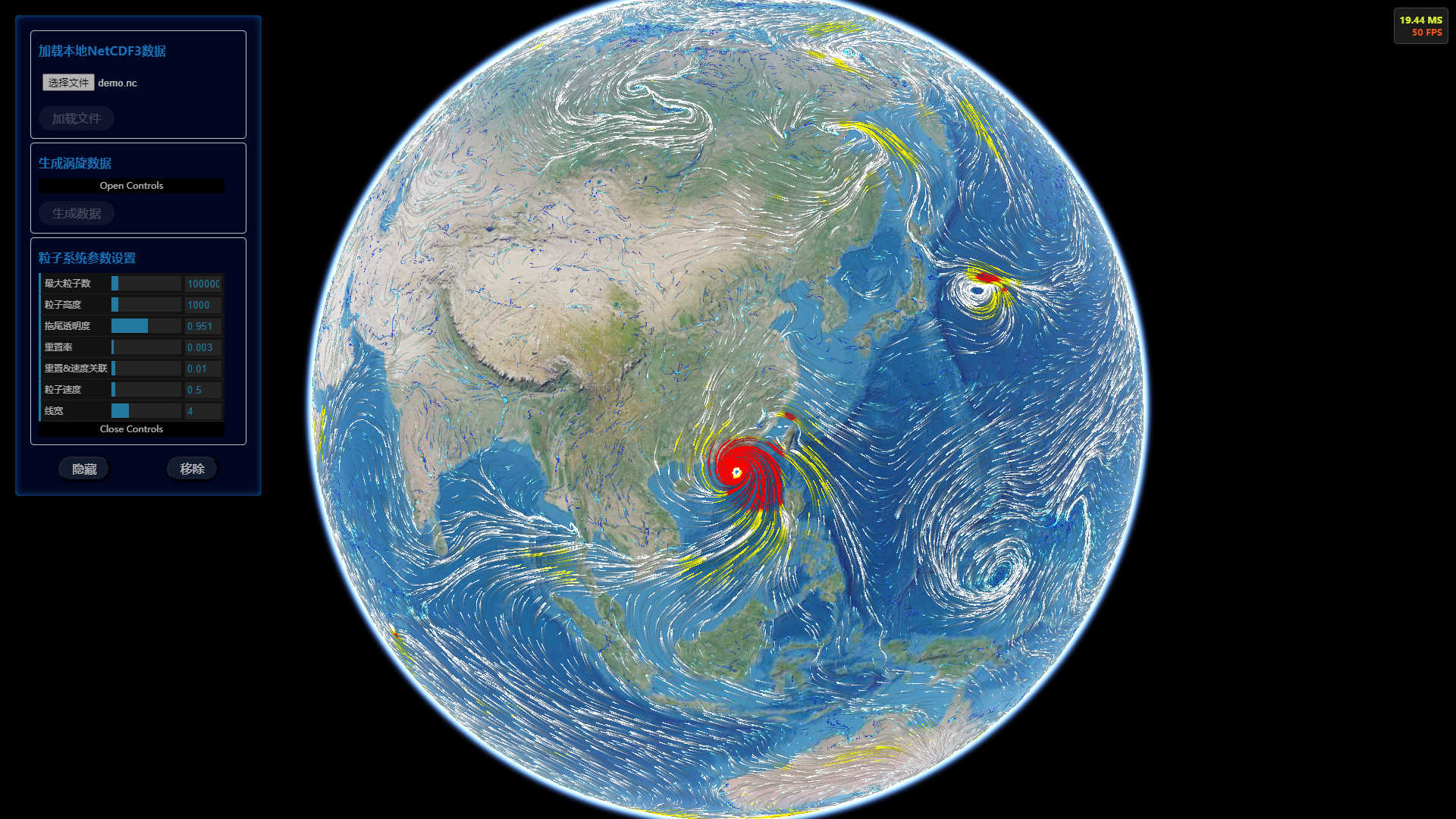cesium-particle-forqd
v0.8.3
Published
cesium particle system module
Downloads
5
Readme
基于cesium的矢量场可视化gpu加速粒子系统


说明
本模块改编自RaymanNg大佬的风场demo。
加载的.nc文件属于NetCDF version 3数据文件,加载其他.nc文件请看Q&A。
本例使用的demo.nc文件分辨率28km,请参考这个网站上的数据 Panoply。
使用说明
Install with npm install cesium-particle, or yarn add cesium-particle
import { Particle3D } from "cesium-particle";例子
import { Particle3D, Vortex } from 'cesium-particle'
import * as Cesium from 'cesium';
// cesiumViewer对象
const viewer = new Cesium.Viewer(cesiumContainer, viewerOption);
// 粒子系统配置
const systemOptions = {
maxParticles: 64 * 64,
particleHeight: 1000.0,
fadeOpacity: 0.996,
dropRate: 0.003,
dropRateBump: 0.01,
speedFactor: 1.0,
lineWidth: 4.0,
dynamic: true
}
// 粒子颜色色带
const colorTable = [
[0.015686,
0.054902,
0.847059],
[0.125490,
0.313725,
1.000000]
]
// 第一种
// 加载demo.nc文件
const file = BolbFile("demo.nc"); // 读取文件
// 从NetCDF3文件生成粒子系统对象
const particleObj = new Particle3D(viewer, {
input: file,
fields: {
lev: 'lev'
}
});
// 加载uv3z.nc、325china.nc或其他自定义文件
const file2 = BolbFile("uv3z.nc");
// 需定义字段名
const particleObj2 = new Particle3D(viewer, {
input: file,
fields: {
U: 'water_u',
V: 'water_v'
}
});
// 第二种
// 构建涡旋模型对象
const parameter = [ [120, 30, 100], 5, 5, 2000, 0.1, 0.1, 2000]; // [['lon', 'lat', 'lev'], 'radiusX', 'radiusY', 'height', 'dx', 'dy', 'dz']
const jsonData = new Vortex(...parameter).getData();
// 从json数据生成粒子系统对象
const particleObj2 = new Particle3D(viewer, {
input: jsonData,
type: 'json', // 必填
userInput: systemOptions,
colorTable: colorTable,
colour: 'height' // 颜色变化跟随速度,可选值: 'speed'(defalut) or 'height'
});
// 启动粒子系统
particleObj.init().then(res => {
particleObj.show(); // 开始运行粒子系统
})
systemOptions.fadeOpacity = 0.900;
particleObj.optionsChange(systemOptions); // 更新粒子系统配置
particleObj.hide(); // 停止粒子系统
particleObj.remove(); // 移除粒子系统API
new Particle3D(viewer, options)
新建一个粒子系统对象,传入的参数包括(ceiusmViewer, {.nc矢量场文件或json对象, 传入的数据类型, nc文件字段规定, UVWH数值范围, 经纬度偏移值, 粒子系统配置项, 粒子颜色色带, 上色的属性})
options配置属性详解:
| Name | Type | Necessarily | Enumeration | Default | | ---------- | ------------- | ----------- | ------------------- | ---------------------------- | | input | File / Object | true | | | | type | String | | 'nc' or 'json' | 'nc' | | fields | Object | | | defalutFields | | valueRange | Object | | | { min: -100, max: 100 } | | offset | Object | | | { lon: 0, lat: 0, lev: 0 } | | userInput | Object | | | defaultParticleSystemOptions | | colorTable | Array | | | defaultColorTable | | colour | String | | 'speed' or 'height' | 'speed' |
默认配置详解:
// 默认的nc文件variables字段
defaultFields = {
U: 'U', // 横向速度
V: 'V', // 纵向速度
W: '', // 垂直速度
H: '', // 高度属性
lon: 'lon', // 经度
lat: 'lat', // 纬度
lev: '', // 层
}
// 默认的粒子运行参数
defaultParticleSystemOptions = {
maxParticles: 64 * 64, // 最大粒子数(会自动取平方数)
particleHeight: 1000.0, // 粒子高度
fadeOpacity: 0.996, // 拖尾透明度
dropRate: 0.003, // 粒子重置率
dropRateBump: 0.01, // 随速度增加的粒子重置率百分比,速度越快越密集,
// 最终的粒子重置率particleDropRate = dropRate + dropRateBump * speedNorm;
speedFactor: 1.0, // 粒子速度
lineWidth: 4.0, // 线宽
dynamic: true // 是否动态运行
}
// 默认的颜色配置
// colorTalbe默认为白色,传入的数组为``[[r, g , b], [r, g, b], ...]``格式
// 例:[[234 / 255, 0, 0], [0, 123 / 255, 0]],对应粒子colour字段值从低到高
defaultColorTable = [[1.0, 1.0, 1.0]]; init()
粒子系统初始化(异步)
show()
粒子系统开始运行,在窗口移动、大小变更、地球缩放、视点相机移动时粒子系统会暂停,停止操作后继续运行
hide()
暂停运行粒子系统
optinsChange(options)
传入粒子系统配置参数,更新粒子运行状态
remove()
从cesiumview中移除粒子系统
getFileFields()
读取NetCDF文件字段,用于加载不同的矢量场文件,参见demo
import { getFileFields } from 'cesium-particle';
const file = File("uv3z.nc")
getFileFields(file).then(res => {
...
/*res: {
variables: ["water_u", "water_v", "depth", "time", "lat", "lon", "time_run"],
dimensions: ["depth", "time", "lat", "lon"],
raw: Object
} */
})Demo
运行说明
yarn / npm install
npm start运行图片
|  |
|  |
| ------- | ------- |
|
|
| ------- | ------- |
|  |
|  |
|
Q&A
更改glsl文件之后未生效
在开发环境中调试glsl文件,需要在.src/modules/particlescomputing.js 和 particlesRendering.js 中修改glsl文件入口:
import { CalculateSpeedShader, UpdatePositionShader, PostProcessingPositionShader } from '../../packages/shader';在webpack.config.js中添加glsl-loader
module.exports = {
module: {
rules: [
{
test: /\.(frag|vert)$/,
loader: 'webpack-glsl-loader'
}
]
}
}或者使用打包命令,打包glsl文件为js:
npm run build-glsl怎样加载自己的.nc文件
.nc文件最好为NetCDF version 3形式
文件中必须至少包含以下属性:
- 横向速度矩阵 U (lev, lat, lon)
- 纵向速度矩阵 V (lev, lat, lon)
- 经度维度 lon(0 - 360)
- 纬度维度 lat
可使用getFileFields()方法读取.nc文件中的属性字段名、维度字段名
并配合构造函数new Particle3D()中传入的fields字段,尝试加载到地球上。
noData值设为0, 或者加载时配置valueRange属性。
如果经度范围不在(0, 360),纬度范围不在(-90, 90),需要配置offset属性。
为什么移除了原作者绘制矩形时采用的Miter Joint算法
请看issue
问题已经定位,后面有机会再尝试解决吧。
其它问题
0.7.0版本之后,cesium引入方式改为
import * as Cesium from 'cesium'
